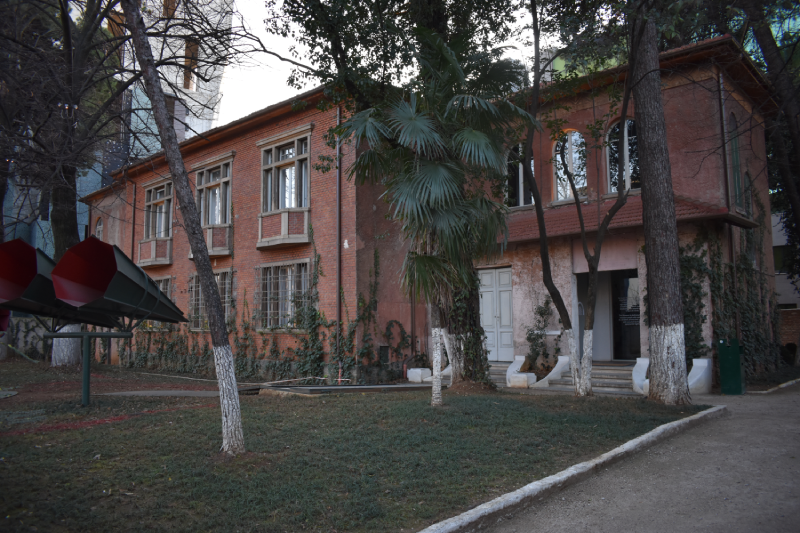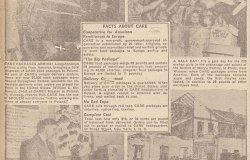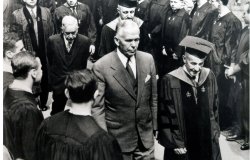
A blog of the History and Public Policy Program
Albania's Museum of Secret Surveillance: The “House of Leaves”
Albania's Museum of Secret Surveillance, often called the “House of Leaves,” opened in 2020 to commemorate the country's experience of Cold War secret surveillance.

Photograph Bes-ART, 23 December 2018, Creative CommonsAttribution-Share Alike 3.0 Unported license.
Situated across from the Orthodox Cathedral of the Resurrection of Christ in Tirana, the former state security service house – a branch of Albania’s KGB – is well worth a visit.
Featured in the 2006 film The Lives of Others, the former obstetrics clinic was a temporary Gestapo headquarters in 1943. Soon after World War II, the Albanian Communist Directorate of State Security – or the Sigurimi – took over the building.
The Museum of Secret Surveillance, often called the “House of Leaves,” opened in 2020 to commemorate Albania's popular experience of World War II and Cold War secret surveillance from 1944 to 1991. An example of transitional justice and of how states in the former Eastern Bloc and Warsaw Pact alliance grapple with the socialist era, the museum won the Council of Europe's Museum Prize in 2020.
Existing scholarship on transitional justice often critically engages the destruction of the historical paper trail, including secret service papers. Not unlike similar debates in colonial history, permanently removing historical evidence is a controversial way of grappling with the past. The Council of Europe thus recognized Albania’s decision to break with this convention by preserving, rather than destroying, a relic of its socialist past. Scholar Nina Gjoci has highlighted the work of the museum in shaping public memory within Albania.[1]
Similar to Berlin's museum exhibitions on the Gestapo and the Staatssicherheit, Albania’s Museum of Secret Surveillance contains a wealth of fascinating objects ranging from old tapping devices to historic documents and a torture room, items that bring a painful history to life. The exhibition is divided into two floors. Many of the materials are presented only in Albanian language. In a way, there are two different kinds of visitors experiences: One for locals who speak Albanian; another for foreign visitors who do not read Albanian or a related language.
Overall, the museum invites the curious visitor to reflect on the role of science and technology within the history of state surveillance agencies. It features, amongst other items, bugged rooms, a darkroom, and an interrogation room. Alongside telecommunications equipment, the museum exhibits everyday items like furniture, handbags, and suitcase locks that were often bugged. The prying ears and eyes of the Sigurimi were never far away from Albania’s citizens, as these items remind visitors.
The museum also demonstrates the transnational nature of science and technology during the Cold War. It puts on display Japanese, Soviet, German, and Chinese spy equipment. How exactly Albania’s spies and state service engineers copied, reverse-engineered, and developed new prototypes is not explained. One conclusion that emerges from the silent dialogue between the objects is that the country’s spies closely followed foreign technological innovations and “research and development” efforts in the field of surveillance.
There is also a garden with an underground tunnel, which is partially open -- likely some kind of civil defense testing environment. Taking a step back, in Albania as in China, scientists engaged in substantive research and development efforts seeking to make affordable, yet functional shelters for different kinds of emergencies. Under Enver Hoxha, a leadership civil defense tunnel network took form in Gjirokastra in the 1970s to protect Albania from a NATO, Yugoslav, or Soviet invasion.
The “House of Leaves” thematizes the dark side of the state security apparatus by putting on display its torture tools. The accompanying graphic illustrations of how they were used is displayed side-by-side with actual forced testimonies from victims. How truthful was the information collected by the Sigurimi? By encouraging the visitor to reflect on the history of investigations and the conditions under which some of the statements on display were made, the museum seeks to encourage the visitor to reflect on contemporaneous questions about data and authenticity.
Whilst standing in the garden with rich tree foliage and listening to the prayer calls from a neighboring mosque, I puzzled over the name “house of leaves”. Nina Gjoci concluded – based on a 2017 visit, prior to the official opening of the museum – that the name of the house came from the overgrown walls, but “house of leaves” is also play on words: the state security practice to keep files on individuals. Spying in service of the state was a common feature of the socialist everyday life, and an issue that all “post-socialist” societies tend to grapple with. In a manner not unlike the German societal debate on the Stasi papers, now that some of the papers of the Sigurimi are on display, do you actually want to know how your neighbors collected information about you for the state?
The museum tries to kindle societal dialogue and encourage (re)encounters with the past through popular memory. Nina Gjoci argues this museum should be visited in combination with the Bunkart space to understand the current ways in which the Albanian government seeks to construct an “exotic and distant communist past” by selectively telling the perpetrators’ story.
I conclude what a non-Albanian speaking historian sees and experiences when visiting the museum is different from that of a local Albanian-speaking historian. Whether this divergence in key take-aways from visiting the museum is intended, or a simple case of information lost in translation is certainly up for debate.
[1] Nina Nazmije Gjoci, “Remaking Albania: Public Memory of Communist Past” (PhD Dissertation, Bowling Green State University, 2018).
About the Author
Katrin Heilmann
Dr. Katrin Heilmann completed her Ph.D. in War Studies at King's College London and a master's degree in China studies at Peking University as a Yenching Scholar. She holds a MA (Hons.) in Chinese and History from the University of Edinburgh.

History and Public Policy Program
The History and Public Policy Program makes public the primary source record of 20th and 21st century international history from repositories around the world, facilitates scholarship based on those records, and uses these materials to provide context for classroom, public, and policy debates on global affairs. Read more

Cold War International History Project
The Cold War International History Project supports the full and prompt release of historical materials by governments on all sides of the Cold War. Through an award winning Digital Archive, the Project allows scholars, journalists, students, and the interested public to reassess the Cold War and its many contemporary legacies. It is part of the Wilson Center's History and Public Policy Program. Read more





